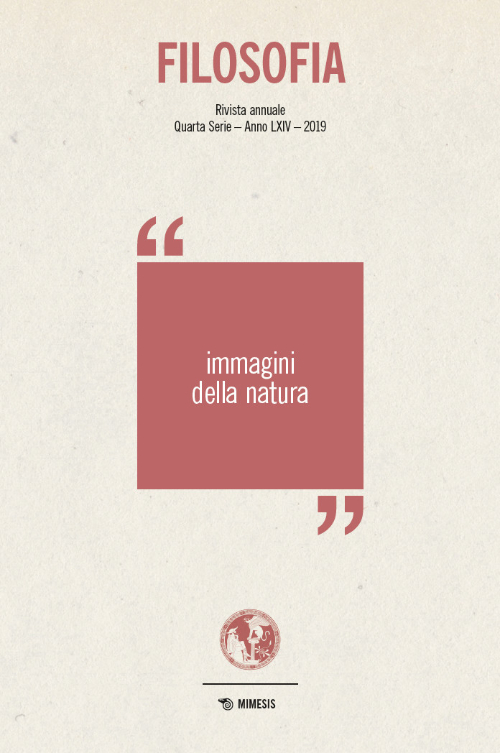Art and nature: the Cusan rethinking of the "imitatio" theme
DOI:
https://doi.org/10.13135/2704-8195/4063Keywords:
art, nature, imitatio, symbol, Nicholas of CusaAbstract
In this article, after a contextualization of the theme ‘art and nature’ in current times and in the Renaissance period, in Nicholas of Cusa’s thought and in its mystical and Neoplatonic sources, we try to situate the question of art in the circle of the “Dionysian erotic” and in its symbolic and doxological meaning. In a second moment, we consider the concept of imitatio in ancient and medieval thought, as a conceptual mediation for thinking the relation between art and nature. In a third moment, we analyze the different occurrences of the “ars imitatur naturam” motif in Cusa’s thought, its presuppositions and the original way he returns to it while thinking about the art of nature and the nature of art. We conclude that the relationship between art and nature is based on an aesthetic ontology, an aesthetic cosmology and an aesthetic anthropology, in which the true beauty develops in nature successive images of itself.
Downloads
References
M. Álvarez-Gómez, Adecuación y Identidad. Sobre la ideia de verdad en Santo Tomás y Nicolás de Cusa, in “Anales de la Cátedra Francisco Suárez”, 4 (1964)
J. M. André, A razão e o real nas suas metamorfoses, in A Filosofia face à cultura tec-nológica, Coimbra, Associação de Professores de Filosofia, 1988, pp. 44-57
J. M. André, Mística y conocimiento en Nicolás de Cusa y en su tratado De visione Dei, in Problemas fundamentales del conocimiento, a cura di M. Álvarez, Salamanca, Sociedad Castellano-Leonesa de filosofía, 1993, pp. 103-124
Aristotele, Physica, B, n. 1, 192 b (cfr. Idem, Physique, vol. I (ll. I-IV), a cura di H. Charteron, Paris, Les Belles Lettres, 1952(2)
W. Beierwaltes, Negati Afirmatio: Welt als Metapher. Zur Grundlegung einer mit-telalterlichen Ästhetik durch Johannes Scotus Eriugena, in “Philosophisches Jahrbuch”, 83 (1976), p. 26
G. Cuozzo, Raffigurare l’invisibile. Cusano e l’arte del tempo, Milano-Udine, Mimesis, 2012
G. Cuozzo, Dentro l’immagine. Natura, arte e prospettiva in Leonardo da Vinci, Milano, il Mulino, 2013
N. Cusano, Sermo CCXLIII, Tota pulchra es, amica mea, et macula non est in te (1456), in Idem, Opera omnia, vol. XIX: Sermones IV, fasc. 3, a cura di W. A. Euler e H. Schwaetzer, Hamburg, Meiner, 2002, n. 13
N. Cusano, Lettera a Nicolò Albergati, in Cusanus-Texte, vol. IV: Briefwechsel des Nikolaus von Kues, a cura di G. von Bredow, Heidelberg, Winter, 1955
N. Cusano, De venatione sapientiae (1463), in Idem, Opera omnia, vol. XII, a cura di R. Klibansky e J. G. Senger, Hamburg, Meiner, 1982
N. Cusano, De coniecturis (1442), in Idem, Opera omnia, vol. III, a cura di J. Koch, K. Bormann e J. G. Senger, Hamburg, Meiner, 1972, II, cap. 1, n. 178
N. Cusano, Sermo CCLI, Nos revelata face (1456), in Idem, Opera omnia,vol. XIX, cit., n. 10
N. Cusano, De beryllo (1458), in Idem, Opera omnia, vol. XI, fasc. 1, a cura di L. Baur, Leipzig, Meiner, 1940, n. 7
N. Cusano, De ludo globi (1463), in Idem, Opera omnia,vol. IX, a cura di J. G. Senger, Hamburg, Meiner, 1998, I
E. de Bruyne, La estética en la Edad Media, trad. cast. di C. Santos e C. Gallardo, Madrid, Visor, 1987
D. Duclow, The Learned Ignorance: Its Symbolism, Logic and Foundations in Dionysius the Areopagite, John Scotus Eriugena and Nicholas of Cusa, Bryn Mawr College, 1974
K. Flasch, Ars imitatur naturam. Platonischer Naturbegriff und mittelalterliche Philosophie der Kunst, in Parusia. Studien zur Philosophie Platons und zur Problemgeschichte des Platonismus. Festgabe für Johannes Hirschberger, a cura di K. Flasch, Frankfurt am Main, Minerva, 1955, pp. 265-306
R. Haubst, Streifzüge in die cusanische Theologie, Münster, Aschendorff, 1991
H. Meinhardt, Exaktheit und Mutmaßungscharakter der Erken-ntnis, in Nikolaus von Kues. Einführung in sein philosophisches Denken, a cura di K. Jakobi, München, Karl Alber, 1972
C. L. Miller, A Road Not Taken: Nicholas of Cusa and Today’s Intellectual World, in “Proceedings of the American Catholic Philosophical Association”, 57 (1983), pp. 68-77
Platone, Respublica, X, 597 b (in Idem, Œuvres complètes, vol. VII: La République, fasc. 2 (ll. VIII-X), a cura di E. Chambry, Paris, Les Belles Lettres, 1982
Platone, Timaeus, 90 d (in Idem, Œuvres complètes, vol. X: Timée, Critias, a cura di A. Rivaud, Paris, Les Belles Lettres, 1970
Plotino, Enneades, VI, 6, 7 (in Idem, Énnéades, vol.VI, fasc. 2, a cura di É. Bréhier, Paris, Les Belles Lettres, 1954(2)
R. Panikkar, El concepto de Naturaleza, Madrid, Instituto Luís Vives de Filosofía, 1951
Pseudo-Dionigi, De divinis nominibus, in Idem, Opera omnia quae existant, a cura di J.-P. Migne, Paris, 1857
G. Santinello, Nicolò Cusano e Leon Battista Alberti. Pensieri sul bello e sull’arte, in Nicolò da Cusa. Relazioni tenute al Convegno Internazionale di Bressanone nel 1960, Firenze, Sansoni, 1962, pp. 147-183
C. Riccati, “Processio et explicatio”. La doctrine de la création chez Jean Scot et Nicolas de Cues, Napoli, Bibliopolis, 1983
G. Santinello, Mittelalterliche Quellen der ästhetischen Weltanschauung des Nikolaus von Kues, in Miscellanea Mediaevalia, vol.II, Die Metaphysik im Mittelalter. Ihr Ursprung und ihre Bedeutung, a cura di P. Wilpert, Berlin, De Gruyter, 1963, pp. 679-685
G. Scoto Eriugena, De divisione naturae, V, n. 3 (in Patrologia Latina,CXXII, a cura di J.-P. Migne, col. 867 A-B)
T. d’Aquino, In octo libros physicorum Aristotelis expositio, II, l. 14, n. 268 (cfr. Idem, In octo libros physicorum Aristotelis expositio, a cura di M. Maggiolo, Torino-Roma, Marietti, 1965)
G. Wieland, Zwischen Naturnachahmung und Kreativität. Zum mittelalterliche Verständnis der Technik, in “Philosophisches Jahrbuch”, 90 (1983)



